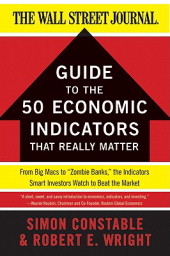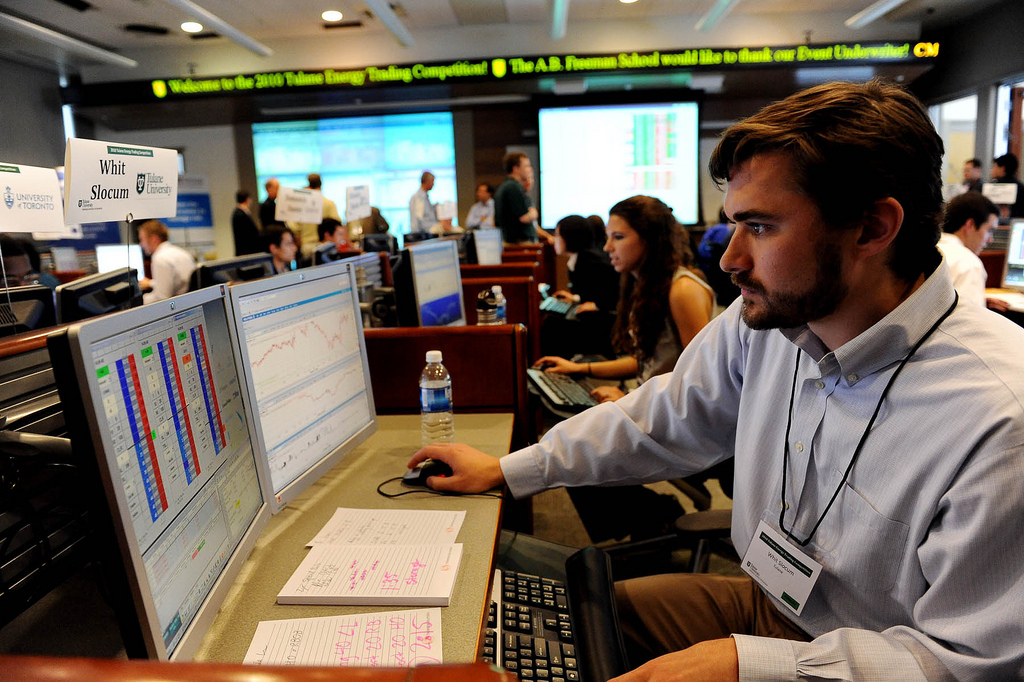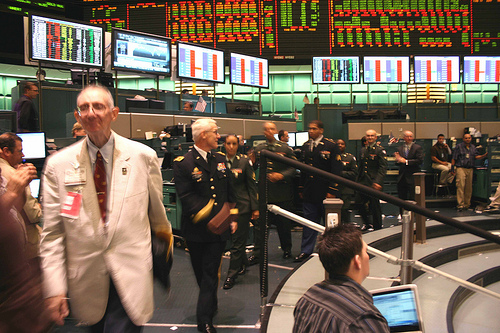5 trends we’re tracking this week
[alert type=yellow ]Every week at Tradestreaming, we’re tracking and analyzing the top trends impacting the finance industry. The following is a list of important things going on we think are worth paying attention to. For more in depth trendfollowing, subscribe to Tradestreaming’s newsletter .[/alert]
1. Edward Jones launches mutual fund family, attracts more money last year than Fidelity, BlackRock and American Funds (BizJournals)
2. Schwab ‘robo adviser’ grows to $5.3 billion in its debut year (Reuters)
3. Will the Department of Labor’s Fiduciary Rule make Broker-Dealers irrelevant in 2016? (Michael Kitces)
4. Fidelity drops credit card partners AmEx, Bank of America, ending 12 year partnership that generated billions in fees (Reuters)
5. The Wall Street Journal is first business publication to get a spot on Snapchat Discover (NiemanLab)
What was Suze Orman smoking when she launched her investment newsletter? (Money)
How to use economic indicators to become a better investor (transcript)
This is a transcript from an interview with Robert Wright, co-author of a new book, The WSJ Guide to the 50 Economic Indicators That Really Matter: From Big Macs to “Zombie Banks,” the Indicators Smart Investors Watch to Beat the Market. You can listen to the program below or go here. Check out our interview archives. Subscribe to receive new interviews on iTunes.
The following transcript was paid for at Speechpad.
Announcer: Live from the Internet, it’s Tradestreaming Radio with your host, Tradestreaming.com’s own, Zack Miller.
Zack: Hey, this is Zack Miller. Welcome to Tradestreaming Radio where we help investors make better decisions with tools, tips, and technology. We speak to some of the smartest and most creative people out there working in this space and hope to illuminate some of these ideas to you.
Today’s guest is a co-author of the new book, The WSJ Guide to the 50 Economic Indicators That Really Matter: From Big Macs to “Zombie Banks,” the Indicators Smart Investors Watch to Beat the Market It was co-written by Simon Constable, a journalist at the Wall Street Journal, and Robert Wright.
Robert Wright will be our guest on today’s show. He is the Nef Family Chair of Political Economy at the Augustana College in South Dakota. Wright is an accomplished author. He has two pages worth of books that he’s published on Amazon. He teaches monetary history. He teaches business. He teaches about price discrimination. What I think makes Wright and this book so valuable for people is that it combines detailed scholarship, really sort of drilling down into numbers, fact-based investing. I’m seeing how some of the leading indicators, some economic data and business data that we read about every day in the paper, how those really impact investing, testing them, going as far as seeing whether these data actually help investors and how profitable they may be as investing strategies. But he’s also a good writer. He’s a self-described cynic, along with Simon Constable, and the book has a very good readability.
Some of the things you might learn about in this podcast, so successful investing means making and keeping above market returns at each stage of the business cycle, and this book very much focuses on trying to determine where we are on the map of the business cycle by looking at certain criteria and then figuring out how to invest based upon that location. Investors must correctly forecast the business cycle before they can know which types of specific investments are likely to generate superior returns.
Wright recommends that looking at investing not as a one-off event. It’s a learning process. This is something I talk about in Tradestream all the time. It’s a lifetime commitment to understanding the economy. Forecasting is more art than science. We know this as investors, and it’s good to have rules-based investing, but we know that no rule is going to be right 100%, and our capacity to accurately predict stems from a combination of historical data and a model that correctly identifies causal agents rather than mere statistical correlations.
There are 50 indicators in this book. Some are well known, some are less well known. It’s a good book. It doesn’t cost a whole lot. It’s like $9.99, whether you buy it in mass market paperback or you buy it for the Kindle, which is where I read. It’s useful. It’s definitely important for business cycle investing. It should deserve an important place on your shelf. Continue reading “How to use economic indicators to become a better investor (transcript)”
Using indicators to become a better investor
On Tradestreaming Radio, we’re interviewing lots of innovative entrepreneurs, investors, and researchers all trying to make investors better at what they do. Check out our archives. Subscribe on iTunes.
We welcome Robert Wright, co-author of a new book The WSJ Guide to the 50 Economic Indicators That Really Matter: From Big Macs to “Zombie Banks,” the Indicators Smart Investors Watch to Beat the Market to Tradestreaming Radio.
Wright is a university professor, prolific author, and a proponent of business-cycle investment philosophy. Along with WSJ columnist, Simon Constable, he’s written an

We discuss:
- Which economic indicators investors should be focused on
- Which economic indicators make money, how much money, and how reliable they are
- New indicators we haven’t heard of before
- How technology is enabling new indicators to help investors to make better decisions
- trends in investment book publishing to experiment with digital, freemium model and why he gives away his college textbooks for free
- creating a broad swath of indicators to best understand all the nuances of the economy
Listen to the whole program
More resources
- If you don’t see the player above, listen to the program here.
- Get the The WSJ Guide to the 50 Economic Indicators That Really Matter: From Big Macs to “Zombie Banks,” the Indicators Smart Investors Watch to Beat the Market
(Amazon)
- Robert Wright’s university page
- Robert Wright (wikipedia)
- Read the whole transcript from this interview
Even more resources
401(k) “re-enrollments”: Nudging employees to make bad decisions
Far be it from me to argue with behavioral economist, Richard Thaler (Nudge was awesome, bro) but 401(k) re-enrollment is only good for the sponsors of such plans like T. Rowe Price ($TROW).
The WSJ is reporting this morning on a growing trend for employers to choose something called “re-enrollment” for their employees’ retirement plans. It goes like this:
Employees have the options of sticking with their current investment selection, if it’s still offered, or choosing another mix. But in a re-enrollment, unless the participant specifically opts out, his or her 401(k) will be re-allocated to the company’s chosen default investment.
Thaler was concerned that employees don’t have enough time/brainspace to make better decisions so it sounds like he likes this approach
“Many [participants] never change their asset allocation or contributions over their working lifetime, meaning that their asset allocation as they get older can be quite different than the one they intended,” says Richard Thaler, professor of economics at the University of Chicago Booth School of Business
Listen, I’m all for nudging children towards better eating habits by the strategic placement and display of such foods in school cafeterias but forcing employees to a made-up allocation for exposure to the stock market…well, not only is that paternalistic, that’s just bad investing.
Digging deeper into target date funds
I understand where the companies are coming from. The data show that rarely — if ever — do employees change their asset allocations. Fine — but what target date funds do is determine exactly how much allocation investors in such funds should have to the market. The hope is that returns will be X over a certain time period (the target date).
But guess what? These things always had too much exposure for most investors to the broad stock market and remain badly markets, explained and disclosed (and that’s the dig by industry rag, Morningstar). Another market plummet and wham, a lot of employees who didn’t even realize they had been re-enrolled will wake up with a lot less $$ in their retirement accounts.
The truth is that target date funds are a flawed product for a genuine problem: helping guide retirement investors to make better decisions. The answer isn’t ensuring they max out on equity allocations.
Only thing this is good for is the stocks of the mutual fund companies who run 401 (k) plans. This smacks of being “the industry solution” for the vast build-up of cash in most retirement accounts.
Well, O retirement investor, consider yourself (re)warned.
As for actionable investment ideas? I’d love to see exactly how much cash there is on the sidelines and expectations for re-enrollment. This could be a good catalyst for Franklin ($BEN) and T. Rowe Price ($TROW) as this cash gets crammed into mutual funds.
Read more
- Your employer knows best. Perhaps. (WSJ)
- New Problems with 401(k) Target Date Funds (Institutional Investor)
- A new 401(k) default? Moving money into target funds (Nudge Blog)
- Morningstar 2010 Target Date Fund Survey (Morningstar)
Did the Chinese and Jewish mother just trade places?
Something strange is afoot in the Sino-Jewish personas.

Mothers, father, educators and children have been talking non-stop about China Mom, Yale Professor Amy Chua’s WSJ take in the WSJ on the superiority of the Chinese method of parenting and the subject of her new book, Battle Hymn of the Tiger Mother (affiliate link).
Chua’s thesis on the difference between Chinese parents and their Westen embodiment — and it certainly helps to sell books — is simple:
Western parents try to respect their children’s individuality, encouraging them to pursue their true passions, supporting their choices, and providing positive reinforcement and a nurturing environment. By contrast, the Chinese believe that the best way to protect their children is by preparing them for the future, letting them see what they’re capable of, and arming them with skills, work habits and inner confidence that no one can ever take away.
Over 7000 comments were received on the original WSJ piece and numerous blog and journalistic responses were launched from the NYT to Newsweek.
New Perspective: A Jewish Doctor of Chinese Medicine
My wife, in her 3rd year of doctorate program in chinese medicine, was taken by this debate. Minda agreed to provide her thoughts on the matter (we’re also parents of 5 kids, ages 3-15 so it’s strikes very close to home). In fact, when I think about it, her response (which I list below) is more Chinese (in the philosophical sense) than China Mom’s original thesis — which strikes me as the type of instruction my grandparents, 1st generation Jewish immigrants, instilled in their children.
My parents were pushed and goaded into performing in a way that I wasn’t. In some way, it’s very immigrant — maybe as the Chinese experience in America evolves, so too the perspective on success and child rearing. Or maybe not.
All of [these responses] sort of beg the question of what are we doing here in this life? if we don’t start with that first question of why we exist, then how do we know what we are trying to accomplish when we raise our children? are we here to play at carnegie hall? are we here to get A’s or high-paying power jobs? a bit superficial, don’t you think? i think the Daoists are rolling over in their grave with all this “chinese” (confucian?) philosophy being thrown around.“The perfect man has no self;
the spiritual man has no achievement;
the sage has no name.”
– Chauang Tzuisn’t life a process? isn’t it our soul meeting the challenges of this life, and somehow in that process our soul is changed and grows? of course that can be played out at carnegie hall or anywhere else one finds themselves, experiencing whatever challenges life has put before them. as we go deeper into ourselves we can unlock and flourish.“Because self-actualizing people ordinarily do not have to abstract need-gratifying qualities nor see the person as a tool, it is much more possible for them to take a non-valuing, non-judging, non-interfering, non-condemning attitude towards others, a desirelessness, a ‘choiceless awareness.’ ” … This kind of detached, Taoist, passive, non-interfering awareness of all the simultaneous existing aspects of the concrete, has much in common with some descriptions of the aesthetic experience and of the mystic experience.”
– Abraham Maslow, Toward a Psychology of Being, 1962, p. 38i’m not really sure that the “chinese mother” is on a mystical path. and so, at the end of the day, what has she done? smoke and mirrors to distract us from the very difficult path of being and find our way in this life. (that said, i am planning a “crackdown” on school work in our house. even the mystics should try to pass 7th grade. it may be a path to transcendence, we will find out).
Stock markets continue to lose share to private exchanges
Institutional investors with large blocks of shares to sell don’t just open up an account at E*Trade and dump them into the market. Doing so tips their hands and astute short sellers can hop a ride on stocks being disposed, making money along the way and reducing profits for the institutional seller.
Conversely, if an institution wants to accumulate shares in a relatively thinly traded stock, they can’t go out to a retail stock broker and say, “Hey buddy, get me 10 million shares of that hot new small cap tech stock.” Doing so would cause the price to rise just by announcing such intentions.
How Institutional Investors Trade
To handle insitutional volumes of stock trading, traders do the following
- VWAP: Some traders will program trading software to purchase a maximum % of volume on given days (called VWAP or Volume Weighted Average Price).
- Smaller trades at various brokers: Sometimes traders will parcel out trades to multiple brokers to mask the fact that a large number of shares are being traded by one institution.
- Dark pools: And sometimes, when there is really an impetus to sell/buy a large chunk of stock, traders will go to their brokers and ask them to cross a block of shares on the low — by not going too public with the info. Execution speed is paramount here and the action is as much in the data centers in New Jersey as it is on Wall Street. These dark pools now account for 1 in 3 shares of stocks traded according to the Wall Street Journal.
In ‘Dark Pools’ Pick up Stock Trading Share, the WSJ takes aim at the rise in these dark pools.
The rise of so-called dark pools and other off-exchange strategies aimed at large banks and institutional traders comes as regulators on both sides of the Atlantic grapple with balancing the market efficiencies the alternative venues say they generate with the impact on individual investors.
Private venues are seen as a more efficient way for transacting large chunks of shares, but critics worry that if so much trading is done privately, publicly available prices set by exchanges will become less accurate. Dark pools are electronic platforms designed for institutions to carry out major stock trades anonymously.
Varying forces
Having 30% of trading beyond the veil of regulators and common investors creates a tiered trading system, something inherently seen as unfair and anti-competitive. The emergence of internal stock trading platforms like powerhouse BlackRock recently announced are not new, they’re just taking on more volume and therefore, importance. In general, we’re witnessing the rise of the machines and algorithmic trading which is the purest combination of technology and investing. The stock exchanges like NASDAQ OMX ($NDAQ) and NYSE Euronext ($NYX) are pleading and crying to regulators to help right this wrong.
Beyond the histrionics, the stock exchanges are also developing technology to help lure institutions back to their platforms. The NASDAQ OMX CEO was on Forbes recently touting the work they’ve done on PSX, an exchange that doesn’t give preference only to speed but also to size of trades. This platform has already demonstrated its ability to bring many of the institutional trades happening offline, back online.
As Felix Salmon said in Wired, “In the wake of the flash crash, Mary Schapiro, chair of the Securities and Exchange Commission, publicly mused that humans may need to wrest some control back from the machines.”
‘Automated trading systems will follow their coded logic regardless of outcome while human involvement likely would have prevented these orders from executing at absurd prices.’
Giving up control to the computers is not really what’s at stake here. Computer trading just reflects the rules-based logic entered by the humans who program the algos. Rather, it’s the essential bifurcation of the markets: one for pros and one for the rest of us. It’s the unleveling of the playing field at stake here that should have everyone concerned.
Source:
Dark Pools Pick up Stock Trading Share (WSJ)
Algorithms take control of Wall Street (Wired)
BlackRock to launch trading platform (FT.com)
photo courtesy of tenaciousmeNew insider trading case could alter buy-side research
Unless you’ve been living in a cave last week (i hear it’s nice there this time of year), you’ve probably seen/heard/felt the aftereffects of the WSJ article U.S. in Vast Insider Trading Probe.
What’s going on
The short of it is:
- the U.S. suspects the existence of multiple insider trading rings
- the size of the impact of this net would vast eclipse previous insider trading networks
- ensnared are consultants, investment bankers, hedge-fund and mutual-fund traders, and analysts
- holy mackerel, batman
Interesting for readers of Tradestreaming and my book is the focus on expert networks. As per the WSJ
One focus of the criminal investigation is examining whether nonpublic information was passed along by independent analysts and consultants who work for companies that provide “expert network” services to hedge funds and mutual funds. These companies set up meetings and calls with current and former managers from hundreds of companies for traders seeking an investing edge.
These expert networks are de facto for most large investment funds. As I wrote, expert networks like Gerson Lehrman provide unique research experiences, connecting fund analyst with industry experts for one-off interviews.
Not all bad
Unlike traditional sell-side research that is distributed to many investors and loses its value with greater distribution, expert networks provide extremely valuable interactions. My book includes an interview with a senior GLG executive. Much of our time spent together was spent dissecting the compliance engine the leading network had put together and I believe this was as much for PR purposes as much as it was for legal purposes.
It is clear that expert networks have been cited numerous times in the past few years as potentially being involved in facilitating investors’ access to material nonpublic information. However, we are convinced that the financial markets are better off using “best of breed” expert networks than without them — Integrity Research
Other insider trading rings busted recently (like Galleon) were their own creations. I have to agree with Integrity Research‘s opinion — this wasn’t by chance. If Galleon’s vast web of insider information had existed on GLG’s platform, there would have been a clear audit trail of who was involved and to what level. That didn’t occur — instead, by using individual contacts, Galleon was able to obfuscate its activities for years.
That wouldn’t have happened using a professional expert network and markets are better off by having these. That said, it’s clear why GLG isn’t able to go public and we’re probably looking at increased regulation of these platforms (which would push more investors to skirt their use).
Heavier hand add more carrying costs
What might happen, regardless of the outcome of this particular probe, is
- increased scrutiny into the investment research space
- some type of oversight/regulation of expert networks
- more distrust of Wall Street by people on Main Street
- employers continuing to crack down on employee participation in expert networks
- formation of ad hoc expert networks (LinkedIn + phone)
- prices going up on expert networks because of increased oversight











